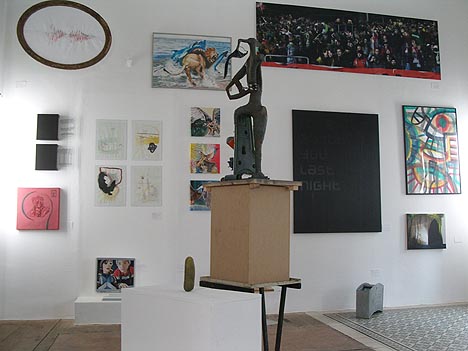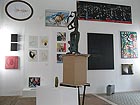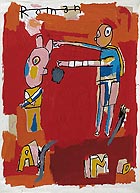
translated and summarized by: Liz Wollner-Grandville,
English summary March 8 - 14
Galerie Area 53
We live and work in Vienna – Brighten the Corners
5.02.10. – 23.04.10
Widened view of the scene
Simultaneously with the opening of the Kunsthalle-exhibition “Lives and works in Vienna III”, Area 53 opened its “We live and work in Vienna”-show – described as a “nice extension of what is really A-listed in Vienna”.
Mounty R.P. Zentara and Karin Sulimma spontaneously sent out invitations to their artist colleagues via Internet and word of mouth, asking them to present any one of their works at the gallery. Being a professional artist and to living in Vienna were the main requirements. No emphasis was placed on style, media or artistic direction; no quality-judgement was passed. The works were accepted as late as up to only three hours before the opening. In contrast with the exhibition at the Kunsthalle, the objectivity (?) of international curators did not play a role.
The artists themselves took charge of organizing the event, which was done in less than three weeks. The number of applications was huge, and among them were numerous renowned artists. The gallery presented 150 works and 850 guests showed up at the opening. A large number of guests came directly from the Kunsthalle-vernissage; they did not want to miss out on this perhaps more authentic and definitely more amusing presentation and party. Area 53 displays a wide range of art – from graphic drawings, classic painting, photography, sculptures, readymade and video to multimedia and interactive installations. In addition to works by lesser-known young artists, artworks by established artists such as Erwin Wurm, Franziska Maderthaner, and Hofstetter Kurt were presented.
With this presentation, Mounty R.P. Zentara and Karin Sulimma continue the counter-action titled “Also lives and works in Vienna” originally initiated by Viktor Bucher on the occasion of “Lives and works in Vienna II”. The gallery owners even radicalized Bucher’s approach by accepting all works submitted to them – making practically no exception. The result offers a very diverse overall view. It renders examples of the rich and contemporary Viennese art - a view that might not be more objective, but definitely more complete, and which contrasts the Kunsthalle-approach with an oscillation between protest and supplement.
By Margareta Sandhofer
Galerie Area 53
1060 Vienna, Gumpendorfer Strasse 53
www.area53.name
Opening hours: Tue – Fri 3 p.m. – 6.30 p.m. Saturdays on request
KW Institute for Contemporary Art
Early Years
28.02.10 – 02.05.10
Convincing arguments
The new Warsaw Museum of Modern Art, which is planned to open in Warsaw in 2014, is currently presenting an exhibition at the Berliner Kunstwerke. “Early Years” is also the first part of an initiative between the cities of Berlin and Warsaw- and in co-operation with Mumbai - in which artists and curators deal with the illusions and promises of happiness in a modern metropolis.
The planned museum construction in Warsaw, designed by the Swiss architect Christian Kerez, is the largest among a series of new museums recently built in Warsaw. And exactly this project is one that points to the spirit, the anticipation, as well as the problems connected to redesigning Warsaw after the re-unification. The exhibition centres on the founding-phase and attempts to reflect on this phase. It deals with the first years of the initiative, which are not characterized by vitality and aspiration, but also by compromise and resistance – something that must be overcome by a project of this size.
Jan Smaga’s work calls attention to the fact that the project is still faced with difficulties. His photo shows the area on which the building will be constructed; with the foreground hidden by a huge layer of ice. This “ice berg” not only symbolizes the impediments the construction is still faced with, but also the yet to be attained social acceptance and the hoped-for thawing of scepticism against the project. How difficult it is to be convincing, especially in this respect, is also shown by Artur Zmijewski’s video work in his series “Democracies”. The Polish artist centres on protests breaking out among shop owners in front of a huge market hall, which is doomed to make way for the museum. Their outrage clearly shows that those responsible still need to contribute convincing arguments for the museum-project to be successful.
In its entirety, the project radiates so much vitality and energetic will and symbolizes a spirit of optimism, which can be sensed among the entire Polish art scene. Selecting Berlin as the exhibition-partner was not only driven by geographical motives. During the course of its history, the German capital was often confronted with having to restart, and even the Kunstwerke Berlin resulted after the German reunification. Both cities have much in common. The reanimated buildings of the former margarine factory in which the Kunstwerke are accommodated, marked the beginning of a new era in the 1990’s. The concept and construction of the new museum in Warsaw will definitely achieve the same.
By Berenika Partum
KW Institute for Contemporary Art
10117 Berlin, Auguststrasse 69
Tel: 0049 (0) 30 24 34 59 0
Fax: 0049 (0) 30 24 34 59 99
www.kw-berlin.de
Opening hours: Tue – Sun: 12 noon – 7 p.m., Thu: 12 noon – 9 p.m.
Galerie Elisabeth & Klaus Thoman
Thomas Feuerstein – where deathless horses weep
07.02.10 – 10.04.10
In the molecular kitchen of a society geneticist
In his exhibition, Thomas Feuerstein cites a scientific experiment and constitutes a lab situation, in which talking about art creates molecular sculptures. The starting points of his new series are objects, paintings, graphics, large sculptures and a biochemical installation. In his works, Feuerstein postulates the text and illustrational translation of procedures and actions - the symbols or “daemonic” codes - that consciously or subconsciously determine our social or biological structures.
The conversation of the exhibition visitors triggers a biochemical process among the elements in the room: the works “velvet mourning” (a biochemical installation, based on Stanley Miller’s concept of the primordial soup, 1953) and “where deathless horses weep” (a bronze horse sculpture, on which humid air condensed and formed a layer of ice).
A further cross-linkage is created between the conceptual narrative of the exhibition and the works “genius in the bottle”; consisting of 72 bottle objects, email graphics on mirror glass, and the wall filling cartographical drawing of a map.
The link between the spoken words and the molecular bonds develops through the formula “drink, speak, distil”: the more humid air emerges from the mouths of the visitors by talking, the richer the condensate for the chemical synthesis becomes – and the more high-proof distillate develops from this, the more talkative the people get. “Speaking about art turns into material of art for elixirs in which bottle genies wait for their media as enzymes, catalysts and programs”, as an accompanying text informs. Art is created from amino acids, glucose, and ethanol – similar to the production of liquor. The preceding discourse on art in the exhibition room turns into a chemically sublime mixture of alcohol from a formerly highly toxic primordial soup - which becomes visible and drinkable by being filled into bottles.
The scientific question on primordial substance, regarding under which conditions different forms of life develop, is paraphrased by Feuerstein as an anthropological evolution, which, in analogy to the “primordial soup”, is based on a cultural soup. The biological conglomerated soups must be regarded as metaphorical figures, forming complex-abstract and even unknown daemonic organizing principles. Social political or economic control mechanisms develop, such as laws, surveillance, media, capital flows, etc. Today’s culture and experiences develop out of a permanently progressing neo-genesis, whereby the control mechanisms are just as implicit as the desire for freedom and independence. It is paradox that the cultivated Lebenswelt applies an attitude, which is hostile to nature, but at the same time concedes to being afraid of the ultimate loss of nature.
In this exhibition, Thomas Feuerstein’s central theme of questioning the relationship between an individual and society in a critical way, once again displays an “open” perspective of genesis as well as its potent geniuses, in other words: daemons.
By Romana Schuler
Galerie Elisabeth & Klaus Thoman
6020 Innsbruck, Maria-Theresien Strasse 34
Tel: + 43 1 512 57 57 85
Fax: + 43 1 512 57 57 85 13
www.galeriethoman.com
Opening hours. Tue- Fri: 12 noon – 6 p.m. , Sat: 12 noon – 5 p.m.
zs art KunstRaum
CX Huth – Pop Goes my World
23.01.10 – 27.03.10
Popular pre-organisation
Beethoven is one of the few Germans who not only contributed to Vienna’s fame, but also died in the Austrian capital. He consciously followed an artist’s tragic fate, who, lonely and deaf and lacking all love and caring, was consoled by the thought of following in Mozart’s and Bach’s footsteps.
This exaltedness to flaunt with the congeniality of others can also be attributed to CX Huth in his exhibition “Pop goes my world”. Even without having read the press release, Dubuffet (drawings), Basquiat (style), and Jawlensky (icon), and possibly even Warhol (strategy) come to ones’ mind. Similar to the Albertina, valuable pedagogic information on the wall informs the visitor that he/she is faced with an internationally renowned artist from Berlin’s district of the Prenzlauer Berg. Beneath his works, the artist added many of the titles in handwriting, together with the year the painting was made, the size, and the price. The slogan on the wall states that there is no question regarding what may not be asked, but every answer could be appreciated as an answer. Or how else should one imagine seeing “a symbolic pop-art-value-world”, which the wall text promises that one sees. Paintings that could decorate any wall in any building – the sauna just as well as the library, the dining room or the living room? These are characteristics attributed to CX Huth’s works and they are underlined by his direct working method, usually combined with primary colours, and show colourfulness spontaneously correlates with figurative illustrations that do not have a deep background. In the gallery room there are pedestals on which black-and-white illustrations attempt to transpose the motives into the room – something that is particularly successful on the landing leading towards the upper room, showing a heart-shaped face on a girl’s body and an astonished egg floating above her. One could easily imagine using the artist’s design on wrapping paper, hand towels, tableware and furnishing fabrics – as it is one of the fine characteristics of pop culture that it fits everywhere; without flustering or worrying that a painting might sweat to much if it is placed near the sauna. Pop doesn’t sweat; it’s in a good mood and doesn’t impose anything onto anyone that was not desired in the first place. Seen this way, pop is the transferral of inspirational marketing strategies into art, and only those who wants art to take place outside of the market, in a seemingly religious immaculate way, could complain.
Beethoven’s “For Elise” is a ring tone for cell phones as well as a melody for numerous hurdy-gurdy organs, but not musical washroom accompaniment at the Albertina; that was taken over by Mozart. Never before has anyone written about those, who cannot be planted into pop culture - thereby one can attest CX Huth that he is forward-looking.
By Gesche Heumann
zs art KunstRaum
1070 Vienna, Westbahnstrasse 27 – 29
Tel: +43 1 895 9395 11
www.zsart.at
Opening hours: Mon, Tue, Wed, Fri: 11 a.m. – 7 p.m., Thu: 11 a.m. – 9 p.m. , Sat: 11 a.m. – 2 p.m.
Mehr Texte von translated and summarized by: Liz Wollner-Grandville


 Teilen
Teilen




